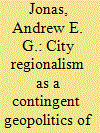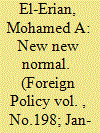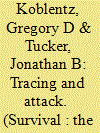| Srl | Item |
| 1 |
ID:
123735


|
|
|
|
|
| Publication |
2013.
|
| Summary/Abstract |
This paper argues that it is intellectually unsustainable to separate the new economic geography of city-regionalism from its geopolitical context. The neo-liberal competition state is centrally implicated in how the city-region scale is politically orchestrated so as to bolster international competitiveness. Yet the diversity of national and sub-national forms of city-regionalism cannot be attributed to economic development considerations separately from ongoing struggles around the collective provision of social and physical infrastructure. Drawing upon selected examples from the United States, the paper demonstrates how city-regionalism expresses the contingent geopolitics of capitalism. Its overall aim is to advance theoretical knowledge both of the internal political geography of the competition state and of its external territorial relations.
|
|
|
|
|
|
|
|
|
|
|
|
|
|
|
|
| 2 |
ID:
110633


|
|
|
|
|
| Publication |
2011.
|
| Summary/Abstract |
The purpose of this article is to examine the potential impact of Hispanics on the electoral geography of the southern United States after the 2010 decennial census. Hispanics are the largest and fastest-growing minority group in the United States today. In addition to traditional Hispanic destinations such as Florida and Texas, many of the areas experiencing the most rapid growth in Hispanic population are southern states such as Georgia, North Carolina, and Virginia. Geographic information systems are used to determine where majority-minority and influential districts are likely to emerge in southern states. We argue that although the Latino population has increased significantly over the past decade, the proportion of Latinos living in southern states remains relatively low in comparison to the general population. Therefore, no new majority-minority or influence districts will emerge in Louisiana, Mississippi, or Tennessee. Majority-minority and influence districts are likely to emerge in Arkansas, Georgia, North Carolina, South Carolina, and Virginia at the state and local levels, but not at the U.S. congressional level. Texas and Florida are the only southern states where new majority-minority and influence districts are likely to emerge at the U.S., state, and local levels after the 2010 decennial census.
|
|
|
|
|
|
|
|
|
|
|
|
|
|
|
|
| 3 |
ID:
127168


|
|
|
| 4 |
ID:
096004


|
|
|
|
|
| Publication |
2010.
|
| Summary/Abstract |
On 18 September 2001, exactly one week after the 11 September terrorist attacks in the United States, five letters containing dry powdered spores of Bacillus anthracis - rugged, seed-like forms of the bacterium that causes anthrax - were mailed to media outlets in Florida and New York City. Three weeks later, two more letters containing a more refined preparation of anthrax spores were sent to US Senators Tom Daschle and Patrick Leahy in Washington DC. The tainted letters contaminated several buildings and caused 22 cases of anthrax (half involving the skin and half the lungs) in five states and the District of Columbia. Five of the people who contracted the inhalational form of anthrax died: two US Postal Service employees in Washington; an employee of American Media, Inc. in Boca Raton, Florida; a 94-year-old woman in Oxford, Connecticut; and a hospital worker in New York City. The anthrax letter attacks also had pervasive ripple effects, forcing thousands of people to take antibiotics as a precaution, disrupting the US Postal Service, temporarily shutting down the US Senate, causing nationwide anxiety about the safety of the mail, and triggering a flood of false alarms and hoaxes involving white powders. All told, the cost of the incident was estimated at $6 billion.
|
|
|
|
|
|
|
|
|
|
|
|
|
|
|
|
| 5 |
ID:
111828


|
|
|